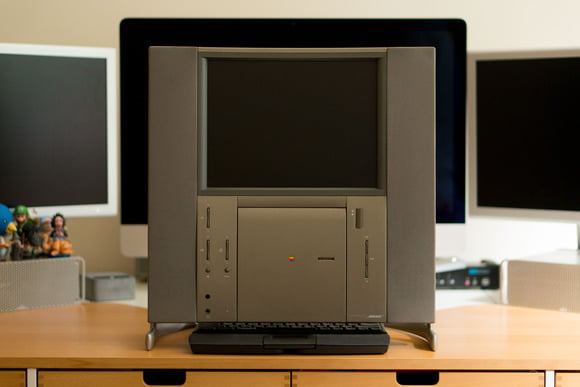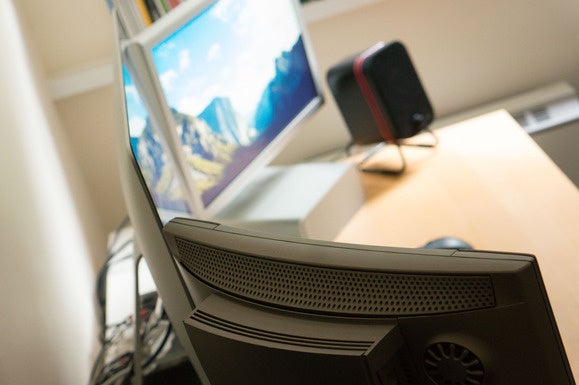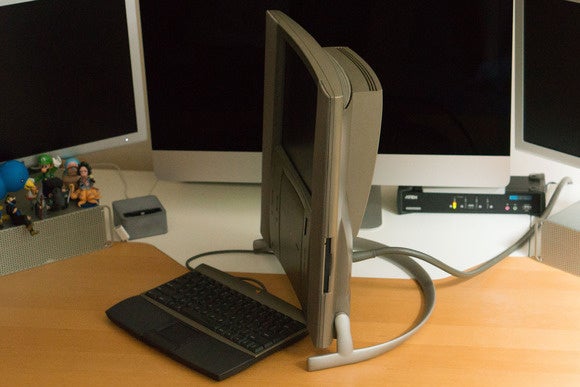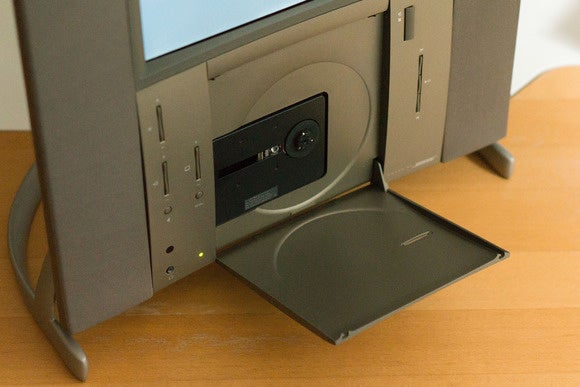

I got not one, but two very exciting Macs this week. The first was a new main Mac, the replacement for my trusty 2008 MacBook Pro: A tricked-out 5K iMac.
The second, though, was just as exciting: I became the caretaker for a Twentieth Anniversary Macintosh, the grandfather of the modern iMac.
The TAM is a complete aberration. It doesn’t fit into any product line, it cost $7,499 when introduced, only a few thousand were made, and nothing like it would ever be made again. Few enough people have ever heard of it, never mind know what one looks like, and fewer still own one. And yet at the same time, the same design decisions that gave us the basic formula for an all-in-one—which we first saw with the iMac G5—clearly informed the design of the TAM.

In essence, the TAM is an iMac: An all-in-one Mac with the components all held in a vertical case behind the screen. It might not seem slim next to the 5-millimeter edge of my new iMac, but for the time when it was introduced in the late ‘90s, it was implausibly, enchantingly slim. This, remember, was the era of bulky,unequivocally three-dimensional computers like the Power Macintosh 5500, behemoth screens like the AppleVision 850, and elephantine peripherals such as the LaserWriter 8500. This stuff was big and imposing and there, but in contrast, the TAM looked flat and ephemeral and somehow self-effacing.
And sure, it’s all a bit of a lie—the same lie Apple peddles still by shouting about that impossibly thin iMac edge while the case bulges pregnantly in the middle—but even viewed from the side, and even with that backpack hump to allow for expansion cards, it nevertheless doesn’t look like a computer that’s pushing twenty years old.

It doesn’t look like a modern computer, either, mind you, but it’s such a weird, rare thing that it’s a glitch in the matrix—you don’t have context or cues to help you decide how old it is.
There are, however, clues. The first is the huge rectangle that dominates the front of the machine: It’s a CD-ROM drive.

CDs are held vertically, of course, and you’ll note there are buttons for controlling playback and volume of audio CDs on the front of the TAM. These hook directly into the CD drive’s hardware, and so, as I was reminded given the TAM’s reputation for not being particularly stable, even if the Mac crashes hard, not only does the music keep playing, but you can still skip forward and back. And oh, how good it sounds! The Acoustimass speaker system was by Bose, and a beautiful external subwoofer gives the whole thing a fat, unctuous sound.

Another clue is on the back: connections for TV and FM radio. The TAM had the cards for these built-in, which was unusual, and prefigured Steve Jobs’ “digital hub” strategy by a few years. Indeed, the TAM was designed in the years when Jobs wasn’t at the company, but although the phrasing is different, you can, I think, hear the young (and hirsute!) Jony Ive articulating the same vision for a centralized, lifestyle device in the video below that Jobs would later describe in the keynote address at 2001’s Macworld Expo.
It’s delightful, isn’t it, to see so many of the familiar tropes from today’s Apple product videos—the cutaways to manufacturing plants, the headshots, the elaborate, hubristic language—were in place so long ago, even if Ive is a little less rehearsed and slick than we’ve come to know him.
The Twentieth Anniversary Macintosh was criticized, and fairly, not only for being expensive but also for being comparatively expensive—and for being an executive toy. But that doesn’t mean it’s not in itself a wonderful, longed-for Mac. It’s an utterly glorious thing, a weird, of-its-era excrescence, a bold attempt at making something state of the art, unfettered by normal commercial concerns. Even if it’s silly, I do miss the daringness and excess of Apple in the ’90s—and the company’s audacity and the experimentalism, which the TAM exemplifies.
My new iMac, the Twentieth Anniversary Macintosh’s spiritual descendent, is vastly more powerful, and has over thirty times the number of pixels, but I love them both equally—just for different reasons.

Now, Macworld readers, I need your help. Before the price of the TAM was dramatically cut, part of what $7,499 bought you was delivery, and we’re not talking a UPS guy lobbing a parcel onto your porch. The original TAMs were delivered in a limo by staff wearing tuxedos, who would set them up for you and show you how to use them. I’d love to write another column filled with interviews of people who either had a TAM delivered in this way or with people whodelivered them—or ideally, of course, both!—and I need your help to track them down. Did you or anyone you know get or do the concierge delivery and would be happy to talk about it for an article for Macworld? The more voices we get, the better the stories will be, but even one will do! Spread the word far and wide, and if you can help, please get in touch on Twitter!
As a bonus for reading my plea, here’s a video of the Twentieth Anniversary Macintosh booting—note the unique startup chime:
[source :-macworld]
